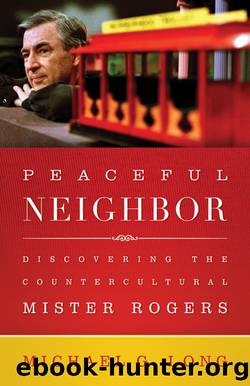Peaceful Neighbor: Discovering the Countercultural Mister Rogers by Michael G. Long

Author:Michael G. Long
Language: eng
Format: epub
ISBN: 9781611645699
Publisher: Westminster John Knox Press
Published: 2015-09-15T00:00:00+00:00
A model of male sensitivity, Rogers often used his program to teach boys and girls that they could act in ways not typically associated with their gender.
Chapter 9
âIâm Tired of Being a Ladyâ
Tough Girls, Sensitive Boys
Although itâs impossible to find the words feminist or feminism in Mister Rogersâ Neighborhood, thereâs no doubt that Fred Rogers used the program to teach and celebrate feminist principles and practices. True to form, he did not join picket lines, marches, or demonstrations seeking equality for women. Rogers was no Pauli Murray, Betty Friedan, or Bella Abzug. But in his own quiet way, he taught girls and women that they did not have to be tied to the identities typically associated with their gender. At the same time, he encouraged boys and men to adopt qualities not normally identified with their gender, especially tenderness, sensitivity, and love. Doing so was Rogersâs way of helping boys and girls combat inner turmoil and achieve an inner peace essential for human flourishing. It was also his way of showing that peace on earth required gender equality, of seeing boys and girls as equal in value and refusing to discriminate against either because of their gender.
Early Gender-Bending
Fred Rogers was the opposite of macho. He showed no hint of physical brawn; his chin was weak, his muscles toned but underdeveloped, and his face eternally smooth. A model of male softness and sensitivity, Rogers cut a striking figure on and off television. He was not aggressive in any way. He talked softly and carried no stick; his spirit was gentle and tender, patient and trustworthy, and receptive and loving. He truly loved children, and loved connecting with them on their own level.
Just the thought of a middle-aged man coming into a childâs home in the middle of the day was countercultural in the 1960s. Most adult males were absent from their homes at that point; they were at work, talking about adult things with other adults. But there was Mister Rogers, taking time before his own workday, or so he told us, to come to his television house and spend thirty minutes of quality time with boys and girls across the nation. Also striking, given the customs of the day, was Mister Rogersâs depiction of himself as the childrenâs âtelevision friend.â He wasnât a teacher, and they werenât his students; he was their friend, and they were his. Thatâs no small point, and it was directly subversive of gender-related expectations of its day.
The first week of the national edition of Mister Rogersâ Neighborhood included another jolting imageâthat of a woman leading a campaign against King Fridayâs preparations for war. Male-dominated institutions executing the Vietnam War were an integral part of the context of that first week. From the White House, President Johnson, an alpha male like none other, directed packs of male soldiers at the Pentagon. Even the major personalities behind the mainstream peace movement were menâMartin Luther King Jr., Benjamin Spock, William Sloane Coffin Jr., Robert F. Kennedy, Eugene McCarthy, and George McGovern.
Download
This site does not store any files on its server. We only index and link to content provided by other sites. Please contact the content providers to delete copyright contents if any and email us, we'll remove relevant links or contents immediately.
Gamestorming The Way Forward by Priya Sarin(323)
The Catastrophic Friendship Fails of Lottie Brooks by Katie Kirby(300)
VA0208 Philip Pullman by Il Conte Karlstein(277)
L. M. Montgomery â Premium Collection by Lucy Maud Montgomery(232)
Double Jeopardy by Franklin W. Dixon(228)
Tale of a Tall Girl (Unfinished Fairy Tales) by Ling Aya(221)
The Crimson Thread by Roy J. Snell(211)
Aya and the Firecats by Gunhild Jensen(203)
Knights and Bikes by Gabrielle Kent(199)
Grover's Guide to Good Eating by Naomi Kleinberg(198)
The Boy With Wings by Lenny Henry(198)
The Mammoth Adventure by Philippa Gregory(192)
Courage, Dana by Susan Beth Pfeffer(185)
The Lost Gargoyle Series 3-Book Bundle by Philippa Dowding(185)
The Magic Thief Complete Collection by Sarah Prineas(180)
Tick Talk by Renée Wehrle(173)
A Baby's Guide to Surviving Mom by Benjamin Bird(172)
Missing Magic by Emma Laybourn(169)
Drooling Dudley by Shelley Swanson Sateren(167)
